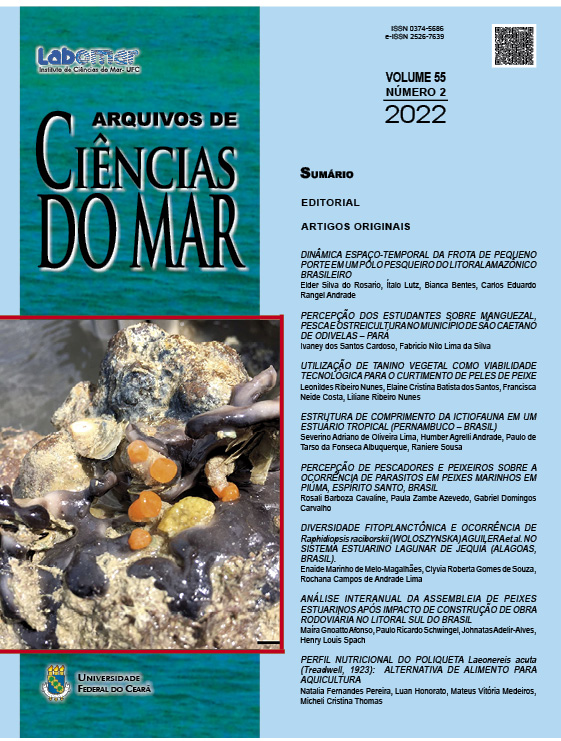First assessment of the ascidian biodiversity from sandstone reefs of a Protected Area in Equatorial Brazil and variations within and between reefs
DOI:
https://doi.org/10.32360/acmar.v55i2.78563Abstract
An assessment of the ascidian biodiversity from three intertidal sandstone reefs was performed in a protected area in the coast of Piauí State (Brazil). Assembly variations in richness, biodiversity and species composition within and between reefs are described. Two horizontal transects (a higher one and lower one) within the ascidian zone were sampled, in each of the three sites. The following species were found: Polysyncraton amethysteum, Botryllus sp., Botryllus tabori, Symplegma brakenhielmi, Euherdmania sp., Eudistoma vannamei, Ecteinascidia conklini, Didemnum duplicatum, Didemnum psammatodes, Didemnum perlucidum. Other Didemnum species which were not identified at the species level (Didemnum sp.1, Didemnum sp. 2, Didemnum spp.) were found. Five other species were not identified at generic level. Species composition reveal very dinstinct assemblies by transect, with very few species in common between transects (higher and lower) within the same site and between sites. ‘Site’ and ‘height’ had significant effects in assembly structure (PERMANOVA, p < 0,05). Lower tansect had always a higher diversity than higher
transect, in the same site. Nonetheless, Botryllus sp. was very common and exclusive of higher transects. Diversity also varied between sites and was very low in a site next to a river mouth. Results are discussed regarding the design of a monitoring protocol for the ascidian fauna from these reefs, and future research on its ascidian biodiversity and conservation.
Keywords: Ascidiacea, tunicates, littoral, Piauí, intertidal, rocky shores.
Downloads
Downloads
Published
How to Cite
Issue
Section
License
1. Proposta de Política para Periódicos de Acesso Livre
Autores que publicam nesta revista concordam com os seguintes termos:
- Autores mantém os direitos autorais e concedem à revista o direito de primeira publicação, com o trabalho simultaneamente licenciado sob a Licença Creative Commons Attribution que permite o compartilhamento do trabalho com reconhecimento da autoria e publicação inicial nesta revista.
- Autores têm autorização para assumir contratos adicionais separadamente, para distribuição não-exclusiva da versão do trabalho publicada nesta revista (ex.: publicar em repositório institucional ou como capítulo de livro), com reconhecimento de autoria e publicação inicial nesta revista.
- Autores têm permissão e são estimulados a publicar e distribuir seu trabalho online (ex.: em repositórios institucionais ou na sua página pessoal) a qualquer ponto antes ou durante o processo editorial, já que isso pode gerar alterações produtivas, bem como aumentar o impacto e a citação do trabalho publicado (Veja O Efeito do Acesso Livre).

